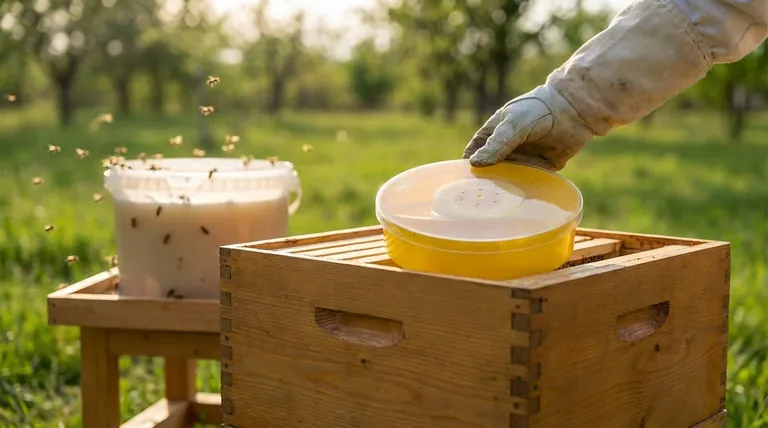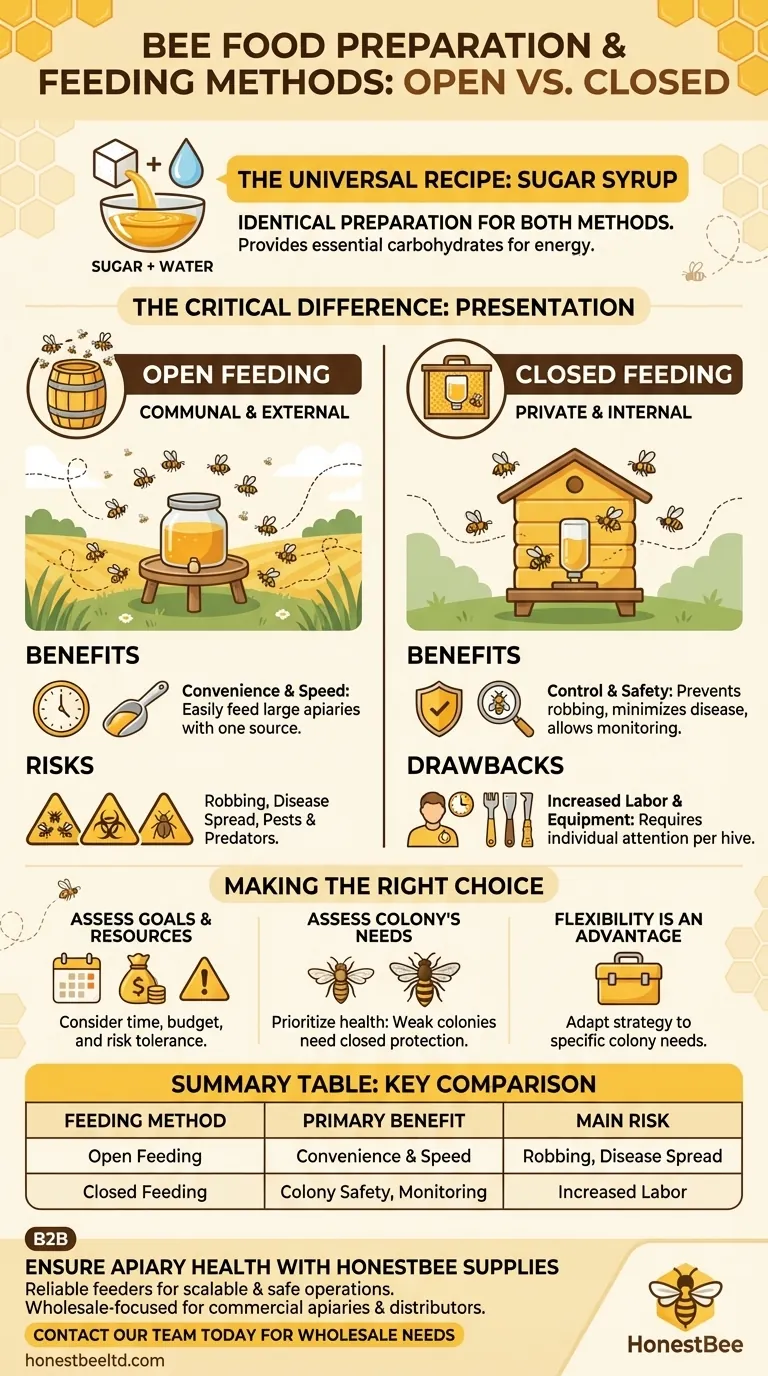The preparation of bee food is identical for both open and closed feeding methods. The recipe is a simple mixture of sugar and water, but the critical distinction lies entirely in how this food is presented to the bees, which has significant implications for hive health and management.
The core principle to understand is that while the food's recipe doesn't change, the delivery method—open versus closed—fundamentally alters the risks, benefits, and labor involved in supporting your colonies.

The Universal Recipe: Sugar Syrup
The foundation of supplemental bee food is a straightforward sugar syrup designed to mimic natural nectar, providing bees with essential carbohydrates for energy.
The Basic Formula
The feed itself is prepared by simply mixing sugar and water. The ratios may change depending on the season and the beekeeper's goal, but the core components remain the same for any feeding style.
Why This Simple Mix Works
This solution provides a readily available energy source that bees can process easily. It supports colony growth, helps them draw out new comb, and sustains them during periods when natural nectar is scarce.
The Critical Difference: Food Presentation
The choice between open and closed feeding is a choice of delivery logistics. One method is communal and external, while the other is private and internal to the hive.
Open Feeding Explained
Open feeding involves placing the sugar syrup in a shared, open container at a distance from the hives. This creates a communal feeding station for all bees in the area. Think of it as setting up a public cafeteria for the entire neighborhood.
Closed Feeding Explained
Closed feeding involves placing the syrup inside a feeder that is contained within or attached directly to a single hive. This ensures that only the bees from that specific colony can access the food. This is the equivalent of providing private, in-room dining for each hive.
Understanding the Trade-offs
Neither method is universally superior; the right choice depends on a careful evaluation of the benefits and significant risks associated with each.
The Case for Open Feeding
The primary advantage of open feeding is convenience and speed. A beekeeper can quickly provide a large amount of food to an entire apiary by filling just one or a few large containers, saving considerable time and effort.
The Risks of Open Feeding
This convenience comes at a high cost. Open feeding encourages robbing, where stronger colonies attack weaker ones to steal resources. It also attracts unwanted pests, predators, and bees from neighboring apiaries, which can facilitate the rapid spread of diseases like American Foulbrood and mites between colonies.
The Case for Closed Feeding
Closed feeding offers control and safety. It protects the food source from outsiders, prevents robbing, and minimizes disease transmission between hives. It also allows a beekeeper to accurately monitor how much food a specific colony is consuming, which is a key indicator of its health and strength.
The Drawbacks of Closed Feeding
The main drawback is the increased labor. Each hive's feeder must be checked and refilled individually, which is a time-consuming process in a large apiary. It also requires purchasing and maintaining a feeder for every colony.
Making the Right Choice for Your Goal
The best method is not fixed; it is a strategic decision based on your resources, the time of year, and the specific condition of your colonies.
Assess Your Goals and Resources
Consider your available time, budget for equipment, and tolerance for risk. As a beekeeper, your personal constraints are a valid part of the decision-making process.
Assess Your Colony's Needs
The health of your bees should be the primary factor. A new or weak colony is highly vulnerable and almost always benefits from the protection of a closed feeder. Strong, established colonies may handle the pressures of open feeding, but the risks remain.
Flexibility is an Advantage
Many experienced beekeepers have multiple types of feeders on hand. This flexibility allows them to adapt their strategy to the specific needs of a colony at any given time, ensuring the bees receive the right support under various conditions.
How to Apply This to Your Hives
- If your primary focus is colony health and targeted support: Closed feeding is the superior method, as it prevents robbing, reduces disease risk, and allows you to monitor consumption.
- If your primary focus is speed for a large, healthy apiary: Open feeding can be used cautiously, but you must be prepared to accept the significant risks of robbing and disease spread.
- If you are managing weak or new colonies: Always use closed feeders to protect them from being overwhelmed by stronger, more aggressive foragers.
Choosing your feeding method is a crucial management decision that directly impacts the well-being of your bees.
Summary Table:
| Feeding Method | Key Characteristic | Primary Benefit | Main Risk |
|---|---|---|---|
| Open Feeding | Communal, external food source | Convenience & speed for large apiaries | Robbing, disease spread, pests |
| Closed Feeding | Private, internal food source | Colony safety, disease control, consumption monitoring | Increased labor per hive |
Ensure your apiary's health and efficiency with the right feeding equipment. The choice between open and closed feeding is a critical management decision that impacts everything from colony strength to disease control. For commercial apiaries and distributors, having reliable, high-quality feeders is essential for scalable and safe operations.
HONESTBEE supplies beekeeping supplies and equipment to commercial apiaries and beekeeping equipment distributors through wholesale-focused operations. We provide the durable equipment you need to implement the best feeding strategy for your colonies' success.
Contact our team today to discuss your wholesale needs and ensure your bees get the support they require.
Visual Guide

Related Products
- HONESTBEE Round Hive Top Bee Feeder for Syrup
- Professional Hive Front Entrance Bee Feeder
- Rapid Bee Feeder White Plastic 2L Round Top Feeder for 8 or 10-Frame Bee Hives
- Classic Boardman Entrance Bee Feeder Hive Front Feeding Solution
- HONESTBEE Entrance Bee Feeder Professional Hive Nutrition Solution for Beekeeping
People Also Ask
- What is the correct method for preparing sugar syrup for bees? Ensure Safe, Non-Toxic Feeding for Your Hives
- How should syrup for bees be prepared? Master the Ratio for a Thriving Hive
- How do you set up and use a top feeder for bees? A Step-by-Step Guide for Safe Feeding
- What features make top feeders a reliable choice for beekeepers? A Guide to Safe, Efficient Hive Nutrition
- Why is a top feeder essential for bees? Ensure Colony Health and Efficiency



















